November 2020
This briefing sets out analysis of ONS labour market statistics released on the morning of 10 November 2020.
What do the data show us overall?
Employment fell by 247,000 on the year, with rises in both unemployment and inactivity. Part of the rise in unemployment was driven by more people who were inactive beginning to look for work as restrictions eased. There was a record level of redundancies and payroll employment is around 782,000 below its March level.
The overall picture is of a weaker labour market: a sharp shock during the first lockdown from March, followed by some recovery during the summer as restrictions were eased, and then signs of further weakening during the autumn as economic support was planned to be reduced and restrictions were tightened again.
The extension of the furlough scheme should help to cushion the labour market through to March. We need to ensure we promote job creation and hiring, and extend support for household incomes and employment support. Vaccine developments are tentatively positive, but restrictions will be with us for some time to come.
Did the expected cliff-edge in furlough support lead to more job losses?
A record rise in redundancies suggests a tougher economic environment and the anticipated end of the furlough scheme in October were associated with job losses.
The Coronavirus Job Retention Scheme (CJRS) has protected millions of jobs. It had been due to end at the end of October. As the pandemic worsened at the start of autumn, the government announced that the CJRS would be replaced with the Job Support Scheme (JSS). While the initial design of the JSS was far less generous than the CJRS, it was later strengthened as more areas were put under tighter local restrictions. Finally, following the announcement of the 4 week national restrictions in England, the government scrapped the JSS and instead extended the CJRS, initially for a month, and later until the end of March.
For many employers with workers on furlough, the anticipated end of the CJRS at the end of October represented a cliff-edge in support. A combination of businesses unable to return to full operation and the expected reduction in support is likely to mean many were forced to consider making furloughed workers redundant.
Chart 1: People made redundant in the last three months
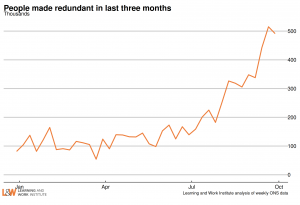
Have local lockdowns had an impact on local economies?
Last week England entered a four-week period of heightened restrictions, with similar national and tiered restrictions in place at various times across the UK.
Prior to the national measures, the UK government and devolved authorities had been seeking to prevent the spread of coronavirus through local restrictions, targeted on areas with higher rates of coronavirus. The government has said that it intends to return to a similar system of local tiers of restrictions in England following the national measures.
Do these local lockdowns have impacts on local labour markets? Leicester had restrictions for the longest period, and showed rises in the claimant count relative to the UK and to Derby and Nottingham in the East Midlands over the period of local lockdown. Despite the local lockdown easing, this had not returned to the UK or East Midland city trend. Nottingham has appeared to be doing better on this measure throughout.
Chart 2: Claimant count change since January 2020
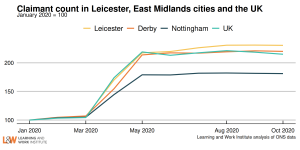
Did ‘Eat Out to Help Out’ have an impact on employment in hospitality?
‘Eat Out to Help Out’ was aimed at boosting the hospitality sector, which had been hit hard by the coronavirus pandemic. Announced in the Chancellor’s financial statement in July, it offered diners a discount on meals from Monday to Wednesday at participating restaurants and pubs, worth 50% of the bill, up to a maximum of £10 per person. Over 100m meals were claimed under the scheme, which the Chancellor suggested had helped to safeguard up to 1.8m jobs. As of 4th September, the scheme had cost £522m.
Vacancies in catering and hospitality increased as the economy partially reopened over the summer and while Eat Out to Help Out was in place. They then fell back once the scheme ended and as restrictions began to be tightened again.
Chart 3: Vacancies by sector
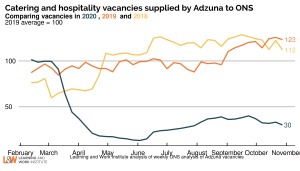
Young people have been hard hit by the crisis, with a surge in unemployment despite more staying in education
There has been a sharp rise in the number of young people taking part in education – up 217,000 or 3.3% of the youth population since January-March 2020. This is often seen during economic downturns and, assuming learning is high quality, can be a positive change given the UK’s longstanding shortfalls in education participation compared to other countries.
Despite this, the number of 18-24 year olds claiming unemployment-related benefits was 516,000 in October, up 120% since March. Young people also saw steeper falls in employment compared to other age groups. This shows the importance of supporting hiring and job creation while maintaining our focus on controlling the virus. It also shows the scale of the challenge that Kickstart, the government’s flagship wage subsidy for employing young people, is trying to address as it begins to get underway.
Chart 4: Youth claimant count since March 2020
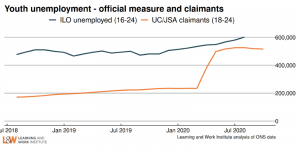
There are 1.9 million people more temporarily away from work than in early March, with millions set to be furloughed until March
There were 3.6 million workers temporarily away from work at the end of September. This is 1.9 million more than at the start of March. The ‘normal’ level includes family and sick leave.
Chart 5: Workers temporarily away from work and jobs furloughed under the CJRS
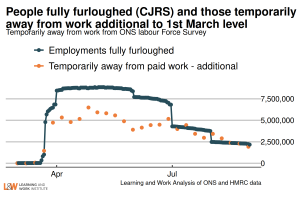
The extension of the CJRS and resurgence of the pandemic, means millions of workers will remain furloughed until the schemes currently planned end at the end of March. Positive developments in vaccine development suggest it is right to provide protection for jobs if social distancing restrictions are able to be eased from spring 2021. However, the blanket extension of furlough support will also protect jobs that will not be viable after the pandemic. As well as furlough support, we need investment in job creation and retraining.
A recent survey of over 5,000 adults across the UK, carried out by Learning and Work Institute, found that furloughed full time workers were less likely to have taken part in learning since lockdown than those who had remained working. This shows the challenge to increase support for upskilling and retraining as not all furloughed jobs will return.